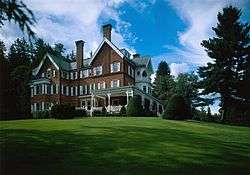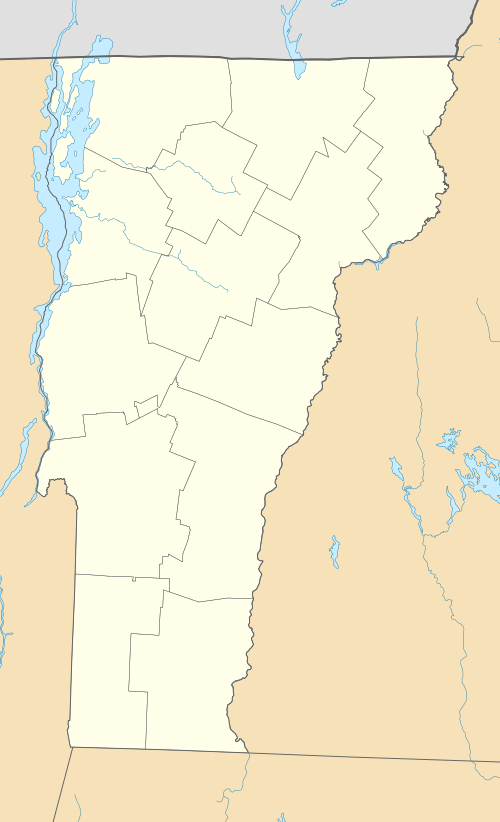George Perkins Marsh Boyhood Home
The George Perkins Marsh Boyhood Home, also known as the Marsh-Billings House, is the architectural centerpiece of Marsh-Billings-Rockefeller National Historical Park, located on Vermont Route 12 in Woodstock, Vermont, United States. The house, built in 1805 and enlarged several times, is historically significant as the boyhood home of George Perkins Marsh (1801–82), an early conservationist, and as the home later in the 19th century of Frederick H. Billings (1823–90), a businessman and philanthropist who was a cofounder of the Northern Pacific Railroad. It is also architecturally significant as a high-quality example of Queen Anne architecture, alterations and enlargements commissioned by Billings and designed by Henry Hudson Holley. The house and its surrounding gardens were declared a National Historic Landmark in 1967.[2][3] The 550-acre (220 ha) estate on which it stands was given by Mary French Rockefeller (the granddaughter of Frederick Billings) and Laurance Rockefeller to the people of the United States in 1992.[4]
George Perkins Marsh Boyhood Home | |
 | |
  | |
| Location | Marsh-Billings-Rockefeller National Historical Park, Woodstock, Vermont |
|---|---|
| Coordinates | 43°37′49″N 72°31′5″W |
| Area | 40 acres (16 ha) |
| Built | 1805 |
| Architectural style | Queen Anne |
| Part of | Marsh-Billings-Rockefeller National Historical Park (ID03000282) |
| NRHP reference No. | 67000023 |
| Significant dates | |
| Added to NRHP | June 11, 1967[1] |
| Designated NHL | June 11, 1967[2] |
| Designated CP | August 26, 1992 |
History
Charles Marsh, a prominent Vermont lawyer, built the core of the present house in 1805, as a fairly typical two-story five-bay Federal style house, and it is where he raised his family. His son George Perkins Marsh was born elsewhere in Woodstock in 1801, and grew up here before leaving for Dartmouth College when he was sixteen. The younger Marsh followed his father into both law and politics, winning election to Congress in 1834 as a Whig, and gaining appointment to diplomatic posts by Presidents John Tyler and Abraham Lincoln. Between the 1830s and 1860s he developed a philosophy of land stewardship which laid the foundation for the conservation movement in the United States with the 1864 publication of Man and Nature, or the Physical Geography as Modified by Human Behavior. This work, updated in 1874, gave a historical assessment of the decline of earlier societies because of a lack of stewardship, and made substantive calls for remedial actions to preserve the natural environment. Marsh died in 1882, never seeing his ideas fully realized.[3]
The Marsh estate, then 246 acres (100 ha), was purchased in 1869 by Frederick H. Billings, a native of Royalton, Vermont who made a fortune as a lawyer dealing with land claims during the California Gold Rush, and was one of the founding partners of the Northern Pacific Railroad, serving as its president from 1873 to 1881. Between 1869 and 1881 Billings commissioned two significant enlargements and alterations to the house, the first adding a wing and a mansard roof, and the second, designed by Henry Hudson Holley, that fully transformed the building into the elaborate Queen Anne Victorian it is today.[3] Billings established what he considered to be a model farm on the property; this part of the estate is now a living history museum and working farm, adjacent to the national park.[4] Billings also constructed 14 miles (23 km) of carriage roads through the upland sections of the estate.
The next major owners of the property were Mary French Rockefeller (Billings' granddaughter) and her husband Laurance Rockefeller. The latter, an influential conservation advisor to several United States presidents, donated the house and upland properties to the people of the United States in 1992, the year the Marsh-Billings-Rockefeller National Historical Park was established.[4] The house and a surrounding 40 acres (16 ha) of land were designated a National Historic Landmark and listed on the National Register of Historic Places in 1967 for their association with Marsh and Billings, and for the house's architecture, which was judged a particularly fine and imposing example of Queen Anne architecture.[3] The house is open for guided tours between May and October; a fee is charged, and reservations may be made in advance, because tour size is limited.
See also
References
- "National Register Information System". National Register of Historic Places. National Park Service. January 23, 2007.
- "George Perkins Marsh Boyhood Home". National Historic Landmark summary listing. National Park Service. Archived from the original on 2008-12-22. Retrieved 2008-02-19.
- Polly M. Rettig and John D. McDermott (May 26, 1967). "National Register of Historic Places Inventory-Nomination: Marsh-Billings House / George Perkins Marsh Boyhood Home" (pdf). National Park Service. Cite journal requires
|journal=(help) and Accompanying three photos, exterior, from 1974 (32 KB) - "Reflections on Environmental History with a Human Face: Experiences from a New National Park" (PDF). National Park Service. Retrieved 2015-03-11.